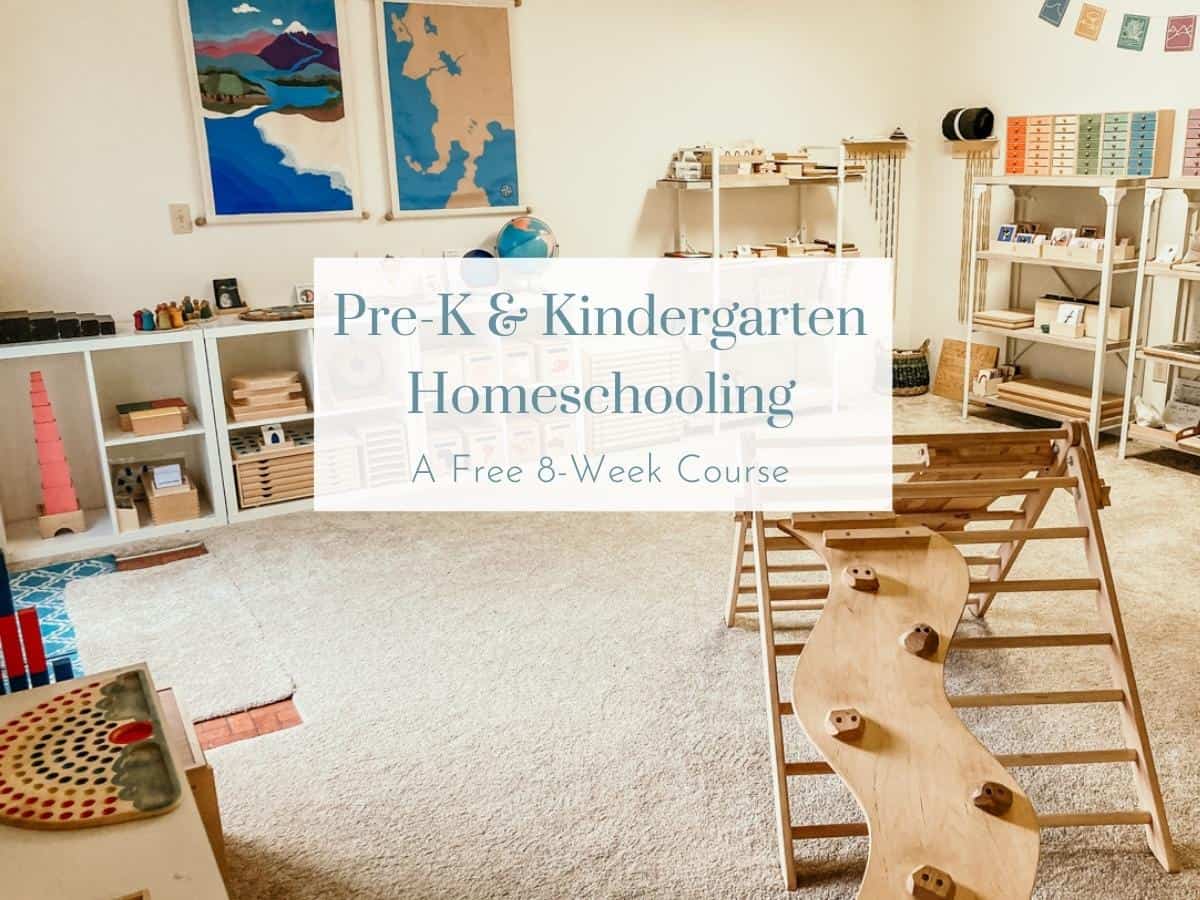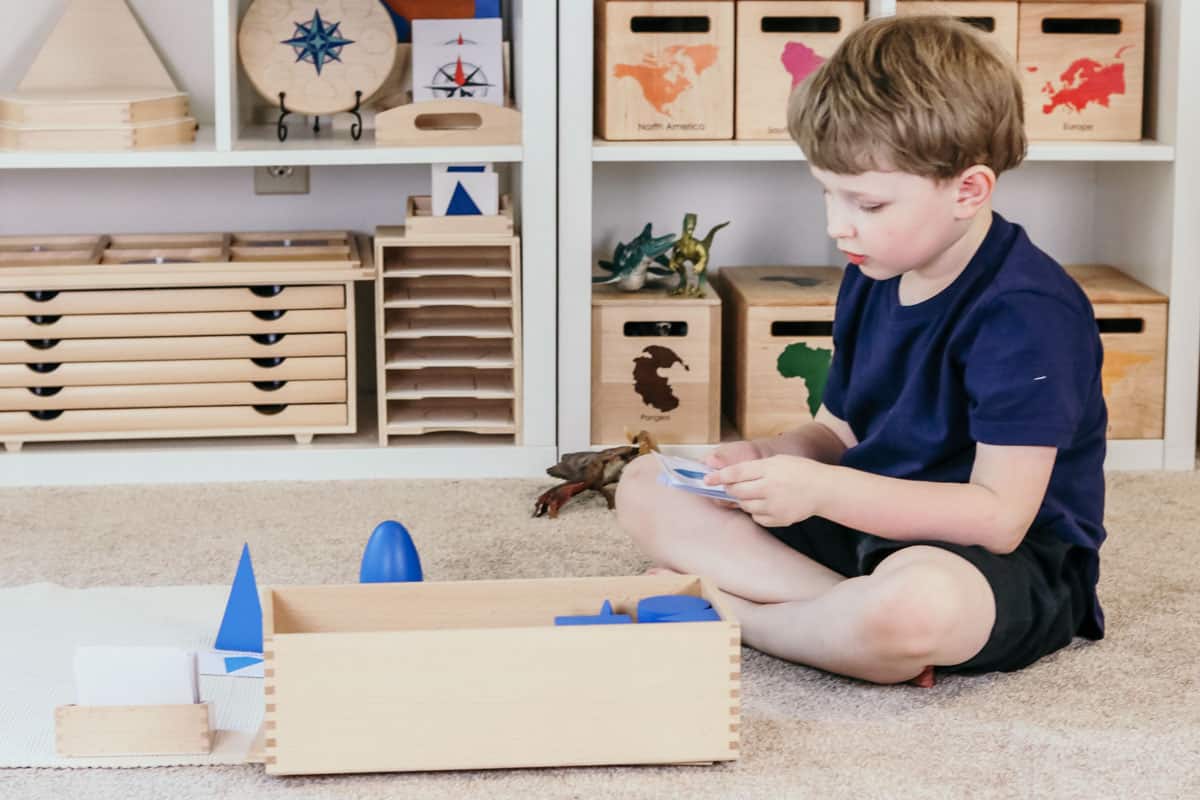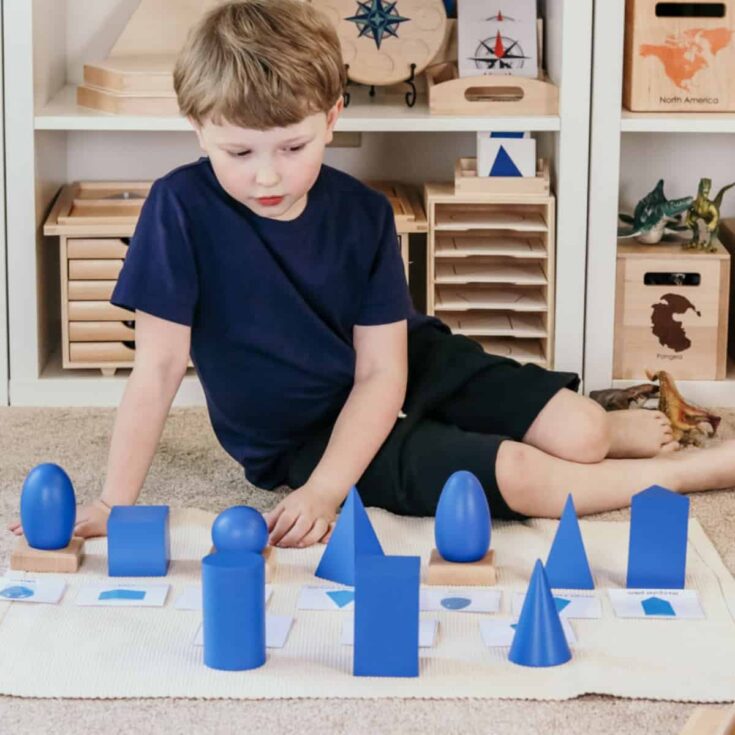
"To understand the Universe, you must understand the language in which it's written, the language of Mathematics."
- Galileo Galilei
Did you know that Montessori kids are introduced to geometry well before high school? It's true. And unlike what you may picture in your mind when you think of geometry lessons, this is actually a really enjoyable experience for all involved.
Read on to see how we use the Montessori Geometric Solids with our preschoolers and grab your free guide.
Disclosure of Material Connection: Some of the links in the post are “affiliate links.” This means if you click on the link and purchase the item, I will receive an affiliate commission. Amazon links are not affiliate links. You can read my full affiliate disclosure.
What are Montessori Sensorial Materials?
Sensorial materials encourage the development and refinement of the five senses. They isolate one sense at a time and have a built-in control of error. This provides the child with the freedom to self-correct without the aid of the guide.
What are Montessori Geometric Solids?
In addition to being just fun objects to hold and play around with, they are used to teach Geometry concepts such as shape (name, edge(s), vertex(ices), sides, base, stand), how they move, what 2d shapes they are comprised of, base shape, families of shapes, common shape combinations, and surface patterns.

Free Pre-K & Kindergarten Homeschool Course
Would you like to learn more about how to homeschool your preschooler or kindergartener the Montessori way?
This 8-week course will provide parents and caregivers with a no-nonsense approach to homeschooling. You will learn how to homeschool using hands-on, child-centered, and diverse learning experiences.
This course covers ALL the relevant subjects. You'll receive information and insight that will help you identify what is best for your child. You'll also be introduced to plenty of free resources along the way.
Most importantly, you will walk away with the tools and resources you need to confidently begin your own homeschooling journey.

Montessori Geometric Solids
These ten attractive and bright blue 3d geometric solids provide our preschooler and kindergartener with a sensorial experience while learning about the shapes that make up most objects found in nature. They are an excellent tool for refinement of order, stereognostic sense/perception, and understanding how objects in our environment consist of a variety of these shapes alone or in combination.

Prior to beginning any formal work with the Geometric Solids, the kids use them in their open-ended play. After they're familiar with the look and feel, they begin formal lessons. For us, that means beginning with the introduction and Three-Period Lesson.
Aside from learning the names of some 2d shapes as toddlers, this is their first substantial introduction to Geometry.

How To Use the Montessori Geometric Solids
- I introduce the sphere, the cube, and the cylinder and progress through the three-period lesson until they have a mastery of that vocabulary.
- We also discuss how each of the solids felt and how they move on the mat.
- We identify the shapes we see on each solid, how many sides, if any, to each solid, and whether each solid has edges or a vertex.
- They also match them to the 2d geometric plane figures that accompany the solids.
- We then play a game in which we each draw the 2d shapes on the easel, and have the other person fetch the matching solid.
- We discuss the difference in the vocabulary between the 2d and 3d version of each shape.
- Then we search for objects in our environment that have the same shape.
- Once that work is completed, I add an additional solid to the lesson and repeat all the steps.
This is the basic procedure we have used for this geometry work, adding a new solid to the mat after each iteration that produces mastery of the work. Sometimes the kids jump ahead, which is cool, and ask about other solids. Our oldest's curiosity usually ended in laughter when she learned what some of the other solids are called. Rectangular prism was her favorite name. She threw her head back and giggled every time without fail.

Nomenclature Cards and Sorting Extension
Once they have an understanding of these four solids, I introduce the 3 part cards and a sorting extension to add interest to this work. The sorting activity contains real images and ties in well with our Montessori Solar System Unit Study as well as our current math shelf work.
As kids increase in their understanding of each solid, I add the associated nomenclature card and sorting extension cards to their shelf work.
What To Do When Your Solids Are Blue
Watch the video to see Noah demonstrate how to use the Montessori geometric solids sorting extension.

More Montessori Geometric Solids Activities
The next step could be introducing a blindfold activity as an additional stereognostic exercise. Also, introducing the concept of an angle adds additional vocabulary when ready.

The book Mummy Math: An Adventure in Geometry is an excellent picture book to reinforce understanding of geometric solids. You can see our copy is well-loved.
In this case, once geometry is understood, it sets the stage for the practical application of that knowledge through art and everyday exploration. Kids will notice objects in their environment that have these shapes and they may proudly point them out.
They may start to grasp the idea that once they have identified the shapes, they can use them to reproduce some of their favorite things on an easel or on paper. It encourages a lot of opportunities with art materials.

In Summary
The Geometric Solids are a really fun Montessori material to work with while learning geometry. There are also plenty of opportunities to extend the learning. I can see why the Geometric Solids are a great segue to the Geometric Cabinet and all the learning opportunities that come with it. Be sure to grab your free guide above. It includes presentation and extension information for the geometric solids as well as the pink tower.
Montessori Materials
Authentic Montessori materials for your homeschool or classroom!

More Preschool Math Resources
Thanks for stopping by!
- Kristin
How to Use the Montessori Geometric Solids

Detailed tutorial on how to use the Sensorial Material: Montessori Geometric Solids, including links for printables, in early childhood education settings. An exciting work for kids throughout the homeschool year.
Materials
Tools
- See Materials List
Instructions
- Introduce the sphere, the cube, and the cylinder and progress through the three-period lesson until the child has a mastery ofthat vocabulary.
- Discuss how each of the solids feels and how they move on the mat.
- Identify the shapes the child sees on each solid, how many sides, if any, to each solid, and whether each solid has edges or a vertex.
- Match them to the 2d geometric plane figures that accompany the solids.
- Play a game in which you each draw the 2d shapes on the easel, and have the other person fetch the matching solid.
- Discuss the difference in the vocabulary between the 2d and 3d version of each shape.
- Search for objects in your environment that have the same shape.
- Once that work is complete, add an additional solid (the cone or whatever the child is interested in) to the lesson and repeat all the steps.
- Once the child has mastered the lessons with the four solids, introduce the 3 part cards and then a sorting extension to the environment. Give the child lessons on how to use these materials and it will extend their interest in the Geometric Solids.
- As the child increases in their understanding of each solid, add the associated nomenclature card and sorting extension cards to their shelf work.
- The book Mummy Math will reinforce knowledge gained while working with the geometric solids while entertaining children with an exciting adventure story.
Notes
Full Lesson Info and Pictures at: https://happyhomeschooladventures.com/montessori-sensorial-materials-geometric-solids-and-how-we-use-them/





Happy Homeschool Adventures
Hi, Celeste! For us, it was beneficial to plan ahead using my scope and sequence for the primary years. I created three categories of Montessori materials. I identified the materials I think are going to 1) add the most value to our children's education, whether that means encouraging the most interest or providing the most versatile opportunities for learning. I also identified which materials we could 2) DIY with a reasonable investment of time and money, and which materials nurtured skills that could 3) be just as easily attained through experiences in the environment or using items we already own. The lists are fluid but they serve as a useful guide.
Armed with that info, I regularly check out what is available via BST pages, Craigslist, local community (schools, homeschool families), the Montessori community, and back-to-school/holiday sales through Montessori distributors. I keep quality and durability in mind knowing that we plan on using these materials for all our children and most quality materials can be passed on to other families when they are no longer of use to us.
If you have the luxury of being patient, I would recommend starting a casual search once you've determined what suits your family. Having a mentor or other Montessori families to share ideas/resources with is extremely helpful. Also, there are some grants/funds available to homeschooling families depending on your location and your family's needs.
Celeste
I love the idea of paying attention to how the solids move! Also the tie in with art is cool – I never made the connection before but it makes sense that as kids gain a more conscious understanding of geometry that it would inform their artistic creations.
How do you decide which materials to invest in? I love the idea of my son having access to all these concrete learning tools but I can’t afford everything so I’m wondering what your process is for determining what’s most important.